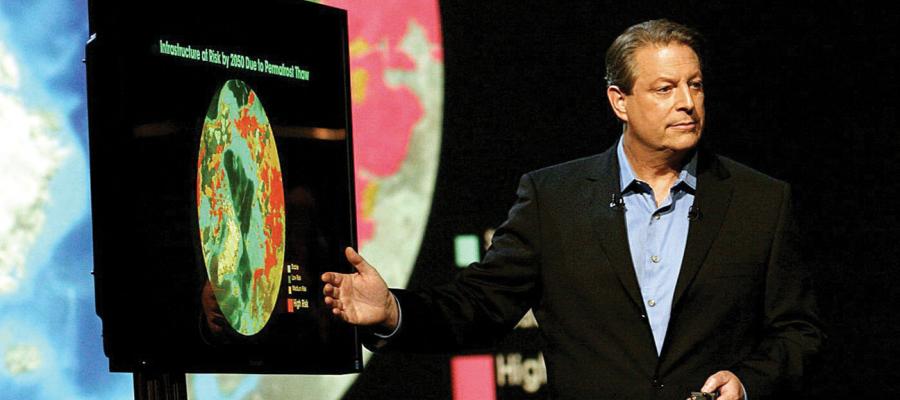Progress and the Environment
Jan 03, 2006Does the value of preserving our environment conflict with the development of a world community in which all enjoy the fruits of human progress?

An Inconvenient Sequel: Truth to Power brings Al Gore’s message of the urgency of addressing climate change to film audiences. Directed by Bonni Cohen and Jon Shenk, produced by Participant Media, with music composed by Jeff Beal, the film will be distributed by Paramount Pictures—they hope to wide audiences. The film interweaves efforts to address climate change since Vice President Gore’s defeat sixteen years ago with strikingly beautiful and disconcerting images of the collapse of the polar ice caps and drought-stricken areas across the globe. People interested in philosophy should see this film not only for what it says about the environment and politics but also for what it says about truth and how to present it.
The story begins and ends with the challenges of climate deniers. As Gore is defeated for the presidency, a satellite with instruments to measure effects of climate change is mothballed. When I wrote this post on the first full day of the Trump Presidency, the White House website no longer referred to climate change but instead sounds themes of “energy independence” from foreign oil and “eliminating harmful and unnecessary policies such as the Climate Action Plan and the Waters of the U.S. rule.” Breitbart quotes the “Weather Channel founder” as labeling the film “another scientific monstrosity.” In a stirring reply to the deniers, the film depicts all the trainings Gore has done for climate activists (with over 10,000 trainees) and the efforts to broker last year’s climate accord in Paris. Gore’s work included convincing a US solar power company to give India access to its intellectual property to help meet that country’s legitimate concerns about its need for inexpensive power sources. (At the time of the Paris accord, there were an estimated 300 million households in India without any power at all and India was planning to construct 400 new coal fired power plants.)
The film’s subtitle is “Truth to Power.” This is a multi-layered pun, with references to telling political leadership and wealthy political contributors tied to the energy industry the truth about human impacts on the climate. It is also a direct confrontation of traditional power sources, describing the growth and economic efficiency of renewable power sources such as wind and solar. And it is a riff on the Quaker slogan “speak truth to power.” But it is only a riff on the latter, for it omits the reference to the spoken word.
Climate science is not always easy to understand. It employs inferences from statistics (given that sixteen of the last seventeen years were the hottest years on record, how likely is it that the explanation is a random shift in the weather rather than human-caused emissions?) and complex modeling (under different assumptions, what are the likely rises in sea levels and their impacts on coastal cities such as Miami or Kolkata?). There are tough questions here for philosophy of science, too, such as questions about the status of models. But An Inconvenient Sequel uses visual imagery for a multi-faceted appeal. Audiences will see glaciers exploding like bombs, lines across Greenland where glaciers were a short 20 years ago, and torrents of glacial melt flowing underneath what is left and accelerating glacial movement. They will also see Al Gore climbing twelve feet up a rickety ladder to get into a Swiss hut for measuring changes in the Greenland glacier. The hut once rested directly on the ice’s surface but is now perched on the exposed pylons that were drilled in deeply to provide it with support. Audiences will also see the 1972 photo of earth from space, in all its island fragility—the last such photo until it was joined by a new photo taken last year. A premise of Gore’s approach to training climate activists—and a premise of the film—is that visual images not only persuade but also demonstrate truth. Much as I loved the film, this last is a particular philosophical challenge; after all, anti-abortionists have for years used visual images of the fetus in utero to make their case. There’s a way to distinguish these: the anti-abortionists are trying to convince people of a normative inference (because the fetus looks like a baby it should be treated like one) and the film is presenting evidence of a scientific hypothesis. Nonetheless, the reasoning here is complex.
After the screening, Gore appeared for an audience Q & A. He emphasized that the film’s hopefulness about the grown of alternative energy is continuing. India has geometrically increased its development of solar power in the last year and is no longer planning to build coal-fired plants. Gore stressed the need for continuing activism, as much on the local as on the national level. One of the featured developments in the film are cities, even in conservative areas of the country, achieving energy independence. And he noted that our political system was designed for a time when print media was the primary mode of communication. Print, unlike television, is a medium with low entry barriers; television ushered in an era of big money in politics. Social media is destabilizing this situation and Gore hopes he will too.